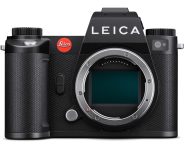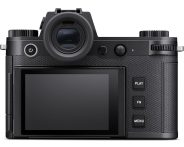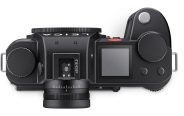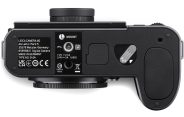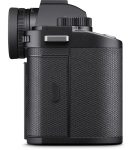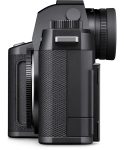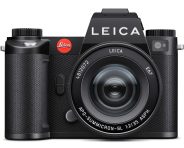Leica SL3
35mm AF digital mirrorless camera
Specification
| Production details: | |
| Announced: | March 2024 |
| Order No.: | 10607 - black |
| System: | ● Leica L (2015) |
| Format: | |
| Maximum format: | 35mm full frame |
| Imaging sensor: | 36 × 24mm CMOS sensor |
| Resolution: | 9520 × 6336 - 60 MP |
| Sensor-shift image stabilization: | Yes |
| Mount and Flange focal distance: | Leica L [20mm] |
| Shutter: | |
| Type: | Focal-plane |
| Model: | Electronically controlled |
| Speeds: | 3600 - 1/16000 + B |
| Exposure: | |
| Exposure metering: | Through-the-lens (TTL), open-aperture |
| Exposure modes: | Programmed Auto |
| Aperture-priority Auto | |
| Shutter-priority Auto | |
| Manual | |
| Physical characteristics: | |
| Weight: | 769.7g |
| Dimensions: | 141.2x108x84.6mm |
| Accessories: | |
| Body cap: | 16060 |
Manufacturer description #1
Wetzlar, 7th March 2024.
The new mirrorless full-frame system camera from Leica is now available. In 2015, Leica Camera AG introduced the SL-System, uniquely combining the two worlds of photography and videography. From the beginning, Leica has focused on partnering with its users and the photographic community to ensure that their products achieve exceptional standards. The result is a system which meets the highest requirements in image quality, manufacturing quality, and ease of handling. Now, the long-established company presents the next generation of the mirrorless full-frame system: the Leica SL3.
The rigorous demands of professional photographers have long served as a benchmark and inspiration for the development of the system, in particular the Leica SL3. The result is an extremely versatile camera, offering unprecedented image quality in both photography and videography. The SL3 combines state-of-the-art technology, extraordinary design, and masterly manufacturing quality – more compact, lighter, and even more user-friendly than its preceding model. The new functions of the Leica SL3 are based on an ongoing dialogue with professionals, which is highly valued and cultivated by the company in the ever-changing world of photography.
At the core of the Leica SL3, you can find the BSI CMOS full-frame sensor with Triple Resolution Technology, which is safely protected in a solid all-metal body with elegant leather. To meet a variety of photographic requirements, the sensor records raw files in DNG or JPEG format with a resolution of either 60, 36 or 18 MP. In each case, the full sensor surface is used. Together with the dynamic range expanded to 15 f-stops and the impressive ISO range from 50 to 100,000, the SL3 delivers remarkably detailed images in outstanding quality – in all light conditions.
With phase detection (PDAF), depth mapping (Object Detection AF), and contrast recognition (Contrast Detection AF), the innovative autofocus system of the SL3 combines the strengths of three technologies to create razor-sharp pictures even in dim light. In addition, intelligent subject recognition supports the photography of dynamic scenes.
The lens bayonet, which is based on the L-Mount standard developed by Leica, facilitates the use of outstanding lenses from all of the Leica camera systems. Additionally, it is compatible with a diverse array of ultra-wide to super-telephoto zoom lenses offered by L-Mount alliance partners. Therefore, the lens bayonet guarantees extensive system compatibility for the Leica SL3. Specifically, the exceptional potential of the renowned Leica M-Lenses is fully harnessed, thanks to the unique design of the image sensor and an external light sensor. The integrated in-body image stabilisation further broadens the scope of application for M-Lenses.
The EyeRes® viewfinder of the Leica SL3 is equipped with an elaborately manufactured optical system made of glass lenses. It always shows the subject crystal clear with up to 120 frames per second and a resolution of 5.76 million pixels. The live preview enables full control over the exposure and composition of images even before releasing the shutter. Another new feature is the tiltable 3-inch high-res touchscreen with a high-quality tilting mechanism. Even more creative possibilities can be achieved thanks to its additional viewing angles.
Videos are recorded in a resolution of up to 8K, supported by efficient codecs such as H.265 and ProRes by Apple. A dedicated time code interface allows for professional image and sound synchronisation on set. Throughout this process, the new Maestro-IV processor with L² technology easily handles the vast amounts of data, resulting in pictures with magnificent colour rendering as well as excellent noise performance.
Another highlight is the new user interface of the Leica SL3. Every optimisation is aimed at enhancing user comfort such as ergonomics, tactile feel, and menu navigation. As a result, the grip, button layout, and overall camera design have been refined to further promote intuitive handling. The updated, streamlined icon and menu design offer a clear structure, facilitating even easier navigation. The distinct separation of photo and video modes proves especially beneficial as it is aided by a specific colour code for differentiation: red for photo mode and yellow for video mode.
Furthermore, the camera’s main functions can be completely adapted to individual needs. The freely assignable FN keys and the optimised touch interaction in the menu add to the intuitive and comfortable operation of the camera. When photographing and filming, the SL3’s user interface aligns itself in landscape or portrait format, depending on the camera position. Thanks to the convenient handling, improved ergonomics, robust design, and IP54 certification, photographers can focus on capturing the shot in any weather and environment. At the same time, the new SL3 is noticeably lighter and more compact than its predecessors and is even more comfortable to use.
The Leica user experience undergoes continuous refinement. Regular firmware updates, influenced by valuable customer feedback, are seamlessly delivered to the SL3 through the Leica FOTOS app. This ensures the camera stays current and future-proof in a user-friendly manner.
The camera’s new interface and improved connectivity ensure a seamless professional workflow. There are slots for the memory cards CFexpress type B and UHS-II-SD, a USB-C port for high-speed data transmission, tethering, and power supply as well as a full-size HDMI 2.1 output for external monitors or recording equipment. Additionally, Bluetooth and Wi-Fi with MIMO technology ensure a stable and fast connection to the Leica FOTOS app. As a certified Apple “Made for iPhone® and iPad®” accessory, the Leica SL3, together with the included USB-C cable, enables a direct connection to Apple products.
The new BP-SCL6 battery, along with the separately available double charger, offers ample capacity. This dual charger allows for the simultaneous and faster charging of two batteries. The double charger and the additional battery are available individually or as an attractive set. Moreover, the accessories within the SL-System now include a new handgrip and a DC coupler. The DC coupler can be inserted into the camera’s battery slot to ensure a continuous power supply via USB-C. The new carrying strap with an innovative attachment and a hard-wearing wrist strap for the hand grip have also been specially designed for everyday professional photography use.
Conclusion: In close partnership with photographers, Leica Camera AG has taken the SL-System to a new level. With an optimised design, efficient user interface, and the versatile L-Mount bayonet, the Leica SL3 is a highly modern, intuitive full-frame camera with outstanding image quality. It combines precision, the best materials, and unprecedented manufacturing quality “Made in Germany”. Robust and reliable, it masters every challenge in photo- and videography, setting new standards in terms of user comfort and a seamless professional workflow with extended interfaces, improved connectivity, and useful accessories.
Manufacturer description #2
The SL3 is a source of inspiration and a trusted companion, elevating the art of visual storytelling to a whole new level. Ideal for those who aim to not only enhance their photography and videography skills, but also for those who want to own the moment, and fully immerse themselves in the joy of the creative process with a Leica.
This mirrorless full-frame system camera is a testament to Made in Germany quality and precision, uniquely combining cutting-edge technology and a user-friendly design with the renowned craftsmanship synonymous with the Leica brand for more than 150 years.
The Leica SL3 delivers images of superior quality and detail in three different resolutions. Its full-frame sensor with Triple Resolution Technology, in conjunction with the legendary Leica lenses and the Maestro IV processor, produces the iconic Leica Look in 60, 36, or 18 megapixels.
An innovative hybrid autofocus system in the Leica SL3 combines three different technologies: phase detection, object detection, and contrast detection.
Thanks to advanced algorithms, these technologies work in harmony to produce a highly precise system.
The SL3 is noticeably more compact and lighter than all its previous models. The camera’s excellent Leica UX design guarantees a user-friendly and personalised operation. With sleek shapes, adaptable user interfaces, and a clear distinction between photo and video modes, the SL3 impresses with outstanding ergonomics at all levels.
A smooth workflow whilst shooting is easily facilitated with swift access to frequently used functions in the control centre.
The system camera’s high-resolution and tiltable display contribute to the user-friendly design, focused entirely on ease of use.
Additionally, the SL3’s interface can be fully customised according to personal preferences.
The SL3 is crafted with precision and attention to detail in Wetzlar, Germany. The solid and entirely sealed full-metal housing is hand-built exclusively from the finest materials, guaranteeing an enjoyable photography experience in all weather conditions for years to come.
The functions of the SL3 have been developed in close cooperation with professionals. As a result, the camera features a variety of connectivity options for data transfer and wireless connectivity. These include slots for CFexpress Type B and SD UHS-II cards, a USB-C port, as well as a full-size HDMI output and a timecode interface. Bluetooth and Wi-Fi ensure a stable and fast wireless connection.
Manufacturer description #3
The Leica SL3's 60-megapixel sensor offers a dynamic range of up to 15 stops, 14-bit colour depth, and exceptionally good noise reduction, guaranteeing breath-taking images. Available in three different resolutions: 60, 36, and 18 megapixels, in both DNG and JPG formats. Its ISO sensitivity ranges from ISO 50 to ISO 100.000, ensuring outstanding results in all lighting conditions. Additionally, camera shake is efficiently compensated by the 5-axis image stabilisation (IBIS).
This state-of-the-art image processor ensures a fast and reliable operation of the Leica SL3’s photo and video applications. Optimised noise characteristics, rapid signal processing, and the unique Leica colour reproduction are just a few of the many aspects this high-performance processor with L2 technology brings to photography and videography, creating the unmistakable Leica look. Specifically for videographers, the Maestro IV supports the data transfer speed of the CFexpress Type B interface and the ability to record 8K videos and a range of highly efficient video codecs.
The SL3’s autofocus system combines three technologies using efficient algorithms. Depending on the shooting situation, the interplay of phase detection (PDAF), depth map (Object Detection AF), and contrast detection (Contrast Detection AF) are optimally adjusted. As a result, the SL3 produces perfectly sharp images in any light. Intelligent subject recognition also supports the photography of dynamic scenes. The strengths of each technology are combined into a highly precise system that effortlessly meets all professional requirements.
Leica's product design has always gained international reputation. The Leica SL3 exceeds all the demands for an intuitive and user-focused operation. With its sophisticated icon and menu design, a touch screen with gesture control, and a clearly structured navigation, the design facilitates a smooth workflow during shooting. Clearly separated by photo and video functions with their own colour scheme: red for photo and yellow for video.
The SL3's main functions can be fully customised to individual needs. Freely assignable FN buttons and additional controls are included, as well as the customisable allocation of frequently used functions in the control centre on the tiltable 3.2-inch touch display. Thanks to the floating design, the icons on the display automatically adjust to the camera's orientation, ensuring optimal readability. With its energy-saving standby mode, the SL3 is ready to shoot at a click of the shutter button.
The SL3 is noticeably lighter and more compact than its predecessors and fits excellently in the hand. An optimised camera design ensures all currently available Leica L-Mount lenses are perfectly balanced, making the SL3 a particularly comfortable tool for demanding creatives. The elegant leather finish, also found on the separately available handgrip, provides an optimal grip and a sophisticated feel.
The Leica SL3 impresses with its robust construction, designed to withstand the challenges of daily use at all times. Exclusive high-quality materials give the SL3 longevity and reliability for years to come. This is also supported by continuous firmware updates that can be easily installed with the Leica FOTOS App. The IP54 certification of the solid full-metal housing guarantees extended protection against moisture and dust, allowing the camera to be used for both photo and video shoots even under adverse production conditions.
The eyepiece of the SL3's electronic viewfinder is meticulously crafted with high-quality coated glass lenses. This enables optimal display of the OLED displays' image inside with a resolution of 5.76 million pixels and up to 120 B/s. Allowing the exposure and composition to be reliably assessed in the Live Preview. Thanks to the integrated eye sensor, an automatic switch between the viewfinder and the Live-View display occurs when the camera is not held directly to the eye.
Among the many interfaces for data transfer and connectivity of the SL3 are slots for CFexpress Type B and UHS-II SD cards, a USB-C port for fast data transfer, tethering and charging, as well as an HDMI Type-A output for external monitors or recording devices. A dedicated timecode interface ensures the synchronisation of image and sound in video productions with multiple cameras. Additionally, Bluetooth and Wi-Fi with MIMO technology ensure stable and fast connection to the Leica FOTOS App. As a result, photos in full DNG resolution can be transferred from the camera to a mobile device within approximately 2 seconds. A mobile workflow that keeps up with the times.

